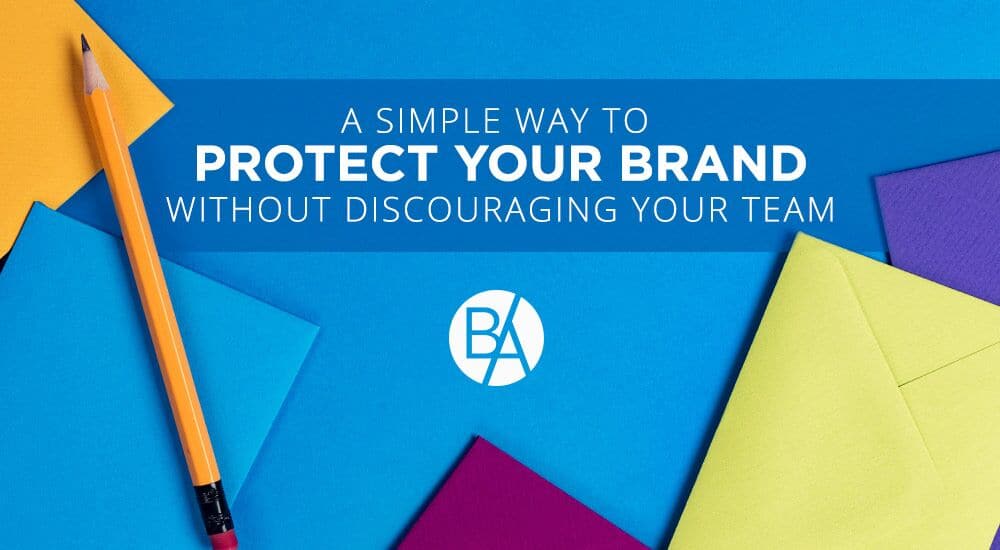One day while I was talking with a leadership team member in my company, I just happened to ask about a project assigned to one of our very creative and empowered front-line employees. Upon further investigation, we discovered that the employee was in the process of procuring tens of thousands of dollars of materials and equipment, without even asking for feedback from another coworker or approval from his supervisor!
On top of that, we learned that the employee had:
- Changed the look of a registered trademark logo.
- Used a color scheme that was completely inconsistent with our corporate marketing image.
- Selected equipment material and design structure that the supplier highly recommended to not use.
- Used a wrong phone number in the marketing messaging specified in this project for potential customers to call.
YIKES!
Immediately, our leadership team member asked the employee to “place the order on hold” so other people on our leadership team could look over his decision.
As the CEO of a growing company, I quickly discovered that the leadership role comes with its share of challenges. Sometimes a leader feels as if he or she is “herding cats.”
One of the principal tasks of a leader is to unify the efforts of their team to achieve common goals. It takes a clear vision, good communication, and a lot of patient reinforcement to “get everyone playing on the same sheet of music!”
What’s a leader to do when a super-empowered and enthusiastic front-line employee decides on their own to implement corporate marketing and communication changes without any input from others?
I don’t know about you, but I only have so many hours in the day. How can I…
- Maintain a unified outside-looking message that reinforces our intentional corporate brand?
- Sustain our processes, policies and procedures to produce consistent results from our team?”
Over the years, I discovered that there were ways to prevent a problem than deal with the mess due to a poor decision even though with good intentions.
One of my companies best Human Resource (HR) policies provided a simple way to prevent these types of poor decision-making.
One-Over-One to the Rescue
Eventually, I instituted an HR policy called One-Over-One to help address this very problem.
So, BEFORE an employee makes any decision to implement the alteration of corporate messaging, company procedures, or the procurement of equipment or materials which would result in changes to the way we do business, must be FIRST approved by the supervisor one level above the supervisor of the employee.
This simple policy helps manage the expectations of everyone involved, especially the team of hard-working employees. And I have found that managing everyone’s expectations does boost job satisfaction!
These potential problems exist in every organization. The good news is that every leader can improve the morale and effectiveness of their organization by adopting this straightforward policy.
Why Does this HR Policy Work?
This policy seems like common sense, and it is.
You very well know that when you order a box of pens to later discover that you ordered the wrong pens, you can return them. However, when we make a wrong decision on matters mentioned in the One-Over-One policy, it is hard to put the “genie back in the bottle” and return to where things were.
Every leader can better manage employee expectations with a One-Over-One policy for the following four reasons:
Using this policy brings about multiple advantages and accomplishes multiple objectives by…
1. Raising the awareness of supervisors and employees regarding the importance of the corporate branding and procedures that we have in place.
2. Recruiting the help of middle and upper-tier supervisors to help maintain consistency in these important areas.
3. Allowing for creative thought and change, while providing guidelines that prevent ineffective or unproductive ideas to grow.
4. Leveraging the time of the leader by providing a structured, yet collaborative way to stay the course while providing a roadmap for new ideas and suggestions.
Every leader can use this policy to improve his or her leadership while also saving valuable time. Incorporating a simple policy like the one above is a no-brainer.
It encourages mutual accountability, and it can help you orchestrate your company’s branding and team’s efforts.
How do you address these situations mentioned above in your organization? Will you consider adopting this HR policy in your own organization? Please share your comments <here> and share this article with your supervisor(s), friend and/or co-worker.
P.S. I am often asked if decision-making is top-down or bottom-up. The answer is both! The participative leadership style that I call Engage2Lead and employs the 1-2-3 leadership tool is usually considered a top-down decision-making process.
However, the One-Over-One policy is an example of a bottom-up decision-making process by using the 1-2-3 process where the employee obtains the approval from their supervisor and that supervisor obtains the approval from their supervisor one level above them.
Are your leading your organization toward growth? Take my FREE Lead2Grow Assessment <here> to understand more. (PLUS – you’ll receive custom-tailored suggestions about next steps to take, starting today!)

